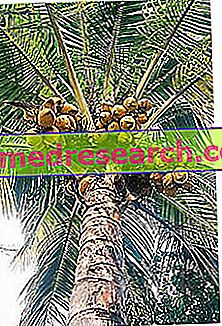The king of vegetables
In botany, the coconut is the fruit of Cocos nucifera (Fam. Arecaceae), the coconut palm: it is a long-lived and powerful plant, typical of countries with a warm-temperate climate; originally from Indonesia and a symbol of the Pacific islands, the coconut palm is still widely cultivated in India, Thailand, Mexico and Brazil.
The coconut palm lends itself to many purposes: in this regard, it is commonly given the name "king of vegetables ".
Botanical description

The entire trunk, columnar and slender, is covered by ring-shaped scars of fallen leaves and racemes; the apical leaves, pinnate and 5 meters long, form a crown. The inflorescences, consisting of small groups of yellow flowers, are spadiciform and racemose. The fruits, on the other hand, are coconuts, oval and voluminous drupes, weighing 0.5-1.5 kilos each: each drupe is wrapped, on the outside, by a smooth exocarp, by a fibrous shell (mesocarp ) in the middle part, while the endocarp is woody and very hard.
The edible internal part is made up of a white flesh with a pleasant, sweet and delicate taste, containing coconut milk.
There are several varieties of coconut palms: the tall varieties are generally very long-lived and survive even beyond 80 years. Dwarf coconut palms, as the term suggests, reach significantly lower heights than the previous variety (max. 12 meters). There are also other varieties of coconut palms that do not fit into either the tall or the dwarf varieties, as they have peculiar and intermediate characteristics.
Uses of coconut
The coconut lends itself to many purposes: the water contained within the fruit, the so-called coconut water, boasts refreshing, diuretic and mildly laxative properties. But that's not all: the liquid is also used for the preparation of fermentable beverages, such as palm wines.

Coconut oil (or margarine), of high economic importance, is obtained from the almond (copra) of the fruit: this represents the matrix for the production of oil, given its high content in lipidic terms (65% fat) .
Sometimes, coconut oil is also used as animal feed: from copra, in fact, by-products are obtained, known as copra panels, useful for these purposes.
Through the incision of the inflorescences, a useful sap is obtained for the production of palm vinegar, wine, sugar and brandy. Even young buds (or coconut palm sprouts) can be used for feeding.
In Tahiti, it is believed that coconut milk is particularly suitable for the sick and convalescents, since it nourishes without weighing the stomach down.
However, the coconut is not only used in the food sector: in fact, the mesocarp fibers are useful for making carpets, ropes, hats, brushes and baskets.
The oil obtained from the coconut is also used in the cosmetic industry for the production of soaps, foams and shaving creams, thanks to its foaming power. Furthermore, the coconut milk applied to the skin in the form of creams or ointments, has emollient and soothing properties, making the skin soft and elastic: in this regard, it is particularly suitable for dry and dry skin.
Of the coconut palm, the trunk is also used: the wood is used for the production of furniture or even for the construction of typically rural houses. Even the leaves are used in the "building" for the roofing of huts.
Coconut oil is also used in phytotherapy, for the production of antiviral, antifungal, antiprotozoal, antimicrobial and antiseptic products (disinfectants).
How to Open and Clean Coconut
Open and clean the coconut ... easy to say! In the video, our personal cooker is looking for the ideal technique to open and clean the coconut ...
How to Open and Clean Coconut
X Problems with video playback? Reload from YouTube Go to Video Page Go to Video Recipes Section Watch the video on youtubeSummary
Cocco: in short
| Coconut | Fruit of Cocos nucifera (Fam. Arecaceae), long-lived and powerful plant typical of warm temperate countries |
| Common name of coconut | King of vegetables |
| Coconut and coconut palm cultivation | Plant native to Indonesia and symbol of the Pacific islands, the coconut palm is widely cultivated in India, Thailand, Mexico and Brazil |
| Cocco: botanical description |
|
| Cocco: food uses | Coconut milk: refreshing, diuretic and mildly laxative properties. Also used for the preparation of fermentable beverages, such as palm wines. Useful for the sick because it nourishes the stomach without weighing it down (Tahitian tradition) Coconut pulp: consumed fresh or used to extract coconut oil or, again, for the production of coconut flour Coconut oil (or margarine): made from the almond (copra) of the fruit, matrix for the production of coconut oil, also used as animal feed From the engraving of the inflorescences a useful sap is obtained for the production of palm vinegar, wine, sugar and brandy Young buds (or coconut palm sprouts): used for food |
| Cocco: uses in cosmetics | Coconut oil: production of soaps, foams and shaving creams, thanks to its foaming power Coconut milk: applied to the skin in the form of creams or ointments, it has emollient and soothing properties. Suitable for dry and dry skin |
| Cocco: uses in phytotherapy | Coconut oil: used for the production of antiviral, antifungal, antiprotozoal, antimicrobial and antiseptic products (disinfectants) |
| Cocco: other uses | Mesocarp fibers: useful for making carpets, ropes, hats, brushes and baskets Coconut palm trunk: furniture production or for the construction of typically rural houses Leaves of coconut palm: also used for covering roofs of huts |



